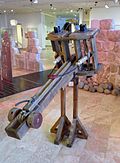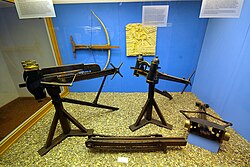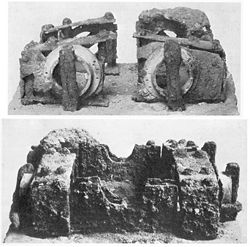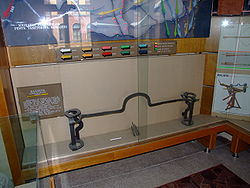Ballista

The ballista (plural ballistae) was one of the first artillery weapons used by the Ancient Greeks.[1] The ballista was invented around 400 BC in the Greek town of Syracuse. It was one of the first catapults, and shot very large and heavy spears far distances.[1][2] The ballista resembled a large crossbow. They were made in different sizes. Smaller ones threw smaller missiles such as scaled-up arrows and darts.
The steps to operating the ballista are:
- Pull back the bow-string with a winch, which creates tension.
- Load the ballista with a light missile e.g. darts with iron points.
- Release the bow-string, launching the missile.
Ballistae would be used if a weapon that fired light, narrow ammunition was needed.
Ballista Media
One talent ballista (26 kg [57 lb] weight projectile) was typical for Roman era ballista. The heaviest version ever made was built by Archimedes, and used stones up to three talents (78 kg [172 lb]).
Roman 'catapult-nest' on Trajan's Column
A four-wheeled carroballista drawn by armored horses, from an engraving illustrating a 1552 edition of the war-machine catalog De Rebus Bellicis (c. 400)
Reproductions of ancient Greek artillery, including catapults such as the polybolos (to the left in the foreground) and a large, early crossbow known as the gastraphetes (mounted on the wall in the background)
Metal components of the Ampurias Catapult, found in 1912 in the Neapolis of Ampurias
References
- ↑ 1.0 1.1 "Ballista: Definition, History & Facts". study.com. Retrieved June 13, 2019.
- ↑ "Ballista ANCIENT MISSILE LAUNCHER". britannica.com. Retrieved June 13, 2019.









